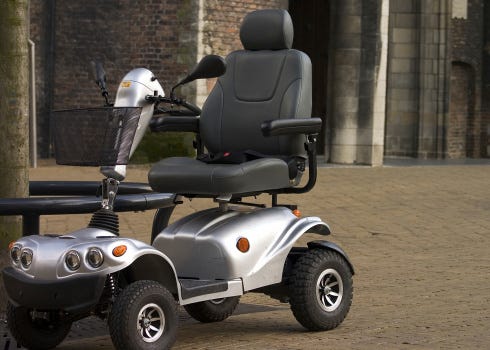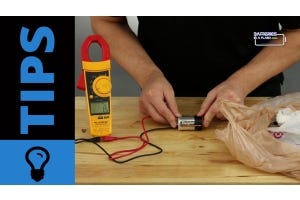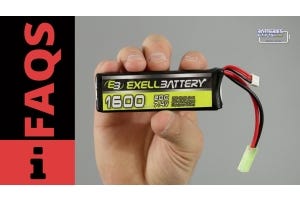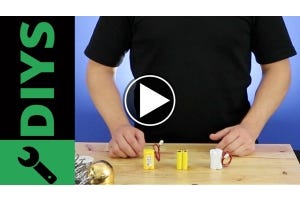How to Charge and Maintain Your Mobility Scooter

It takes you to the park, the mall and the supermarket. Without its help, you might rarely leave the house, but what have you done for it lately? Just a few minutes a day spent caring for your mobility scooter will pay off in the end. Here are some ways to extend its life.
Keep the Battery Charged
While some models may require charging after every use, other manufacturers recommend waiting until your battery gauge tells you that it's time. Many experts, however, recommend charging your scooter's battery every night, regardless of whether you'll be using it the next day. Most batteries should remain on the charger for at least eight hours, but overcharging is never a good idea. Anything over 18 hours will only cause harm. With a small electric scooter, it is often possible to remove the battery pack entirely and perform the charge at some distance from the vehicle. Other models, however, require that the batteries remain on the scooter while charging. If such a scooter is too large to bring inside, you will have to provide an outlet in your shed or garage.
Prolong the Battery's Life
While a mobility scooter's battery will normally last between one and two years, its longevity will depend on such variables as: - The terrain it usually navigates. - The distances it normally covers. - The maintenance it generally receives. Regularly scrubbing the battery's terminals with a wire brush and a mixture of baking soda and water can help prolong its life. Be sure to let everything dry completely before reconnecting.
Invest in a Battery Upgrade
Traveling long distances at a clip over hills and valleys will take the moxie out of any battery. If your mobility scooter will accept it, a larger battery will allow you to go further on a single charge. It will also add to the scooter's overall weight, which may be a consideration if you intend to transport the scooter frequently.
Storing the Battery
When putting your battery into storage, remember that a cool, dry spot combined with periodic charges will prolong its life while stashing it in a hot, cold or damp location will cause its death knell to sound rather quickly.
How Often Should I Service My Scooter?
Although the vast majority of scooters thrive on once-a-year servicing, the recommended frequency depends upon the use to which their owners subject them. The service itself should normally include a check of the seat mechanism, a lubrication of the brakes and a replenishment of air in the tires.
Maintaining Your Scooter at Home
Regular maintenance can prolong the life of your mobility scooter while preventing serious problems. On a regular basis, you should think about: keeping it dry, clean, and keeping an eye on the placement and security of all nuts, bolts, fuses and cables. Without good wheels, your scooter won't take you very far, so attention here is crucial. If the tires are inflatable, check the pressure. If the wheels are hard, inspect them for excessive wear and tear.
Care is a two-way street; your mobility scooter provides you with a quality of life you might not otherwise enjoy. If you give it the care it deserves today, it will continue to serve you long into the future.







Your scooter comes with 12Ah batteries which is about as big as you can get them. You could find 15Ah batteries which are about the same size as the 12Ah but the cost of them may not be worth the trouble. The solar panel is a good idea. Just be sure to use type of charge controller to ensure your not overcharging the batteries. What solar solution are you thinking about?
I'm a retired time served electrical/electronics chappie. All lead acid batteries last longer if kept fully charged. It is a chemical thing and a discharged, or partly discharged battery begins to sulphate the plates and will eventually kill the battery.
Most modern chargers for mobility scooter are designed to be left permanently connected so as to do this. They are also usually suitable for all types of lead acid battery including Gel and AGM. It is better to charge these at a modest charge rate of around 1.5 to 2 Amps as, being sealed, they must be charged with a lower voltage and current to prevent gassing.
I find the most frustrating thing is the dearth of reasonably priced in-car chargers that charge the 24volt battery from the 12 volt car charging system. These maintain the charge of the scooter as the car drives around. Thus, if you are, for example shopping and driving from shop to shop, the in-car charger tops up the batteries.
It is possible to set up a system to plug in a battery charger/maintainer at home to keep the vehicle's battery charged/topped up which then also maintains the scooter in-car charger to maintain the scooter batteries as fully charged.
The problem being that unless you do have a vehicle battery charge maintainer it is all to easy to forget to disconnect the in-car charger set-up and find the vehicle battery flat on your next attempt at a trip to the shops.
What I'm aiming at is an integrated system that keeps both the vehicle and buggy batteries in tip top condition for as long as it is possible to do so. As my daily use vehicle is a small camper van that has mains hook-up and both a vehicle and habitation battery I have such an ideal system. Failing the use of a 12 to 24 volt in car charger the solution is a mains inverter to drive the scooters provided charger. This is less ideal as the extra 12 volt DC to 240 volt mains to 24 volt DC is not so efficient.
Anyhow keep up the good work - if we don't do our best to help each other there are few others why will.